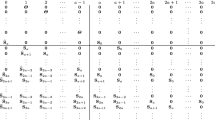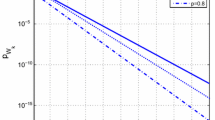Abstract
This paper considers a single-server queueing model with finite and infinite buffers in which customers arrive according to a discrete-time renewal process. The customers are served one at a time under discrete-time Markovian service process (D-MSP). This service process is similar to the discrete-time Markovian arrival process (D-MAP), where arrivals are replaced with service completions. Using the imbedded Markov chain technique and the matrix-geometric method, we obtain the system-length distribution at a prearrival epoch. We also provide the steady-state system-length distribution at an arbitrary epoch by using the supplementary variable technique and the classical argument based on renewal-theory. The analysis of actual-waiting-time (in the queue) distribution (measured in slots) has also been investigated. Further, we derive the coefficient of correlation of the lagged interdeparture intervals. Moreover, computational experiences with a variety of numerical results in the form of tables and graphs are discussed.
Similar content being viewed by others
References
Albores-Velasco FJ, Tajonar-Sanabria FS (2004) Analysis of the GI/MSP/c/r queueing system. Inf Process 4: 46–57
Alfa AS (2002) Discrete time queues and matrix-analytic methods. Top 10(2): 147–210
Alfa AS, Sengupta B, Takine T, Xue J (2002) A new algorithm for computing the rate matrix of GI/M/1 type Markov chains. In: Proceedings of the 4th international conference on matrix-analytic methods, Adelaide, Australia, 14–18 July 2002, pp 1–16
Alfa AS, Xue J, Ye Q (2000) Perturbation theory for the asymptotic decay rates in the queues with Markovian arrival process and/or Markovian service process. Queue Syst 36(4): 287–301
Blondia C (1993) A discrete time batch Markovian arrival process as B-ISDN traffic model. Belgian J Oper Res Stat Comput Sci 32: 3–23
Bocharov PP (1996) Stationary distribution of a finite queue with recurrent flow and Markovian service. Automat Remote Control 57: 66–78
Bocharov PP, D’Apice C, Pechinkin AV, Salerno S (2003) The stationary characteristics of the G/MSP/1/r queueing system. Automat Remote Control 64(2): 127–142
Bruneel H, Kim BG (1993) Discrete-time models for communication systems including ATM. Kluwer Academic Publishers, Boston
Chaudhry ML (2000) On numerical computations of some discrete-time queues. In: Grassmann WK(eds) Computational Probability. Kluwer Academic Publishers, Boston, pp 365–407
Chaudhry ML, Gupta UC (1996) Performance analysis of the discrete-time GI/Geom/1/N queue. J Appl Probab 33: 239–255
Chaudhry ML, Gupta UC (2003) Analysis of a finite-buffer bulk-service queue with discrete-Markovian arrival process: D-MAP/G a,b/1/N. Nav Res Logist 50: 345–363
Chaudhry ML, Gupta UC, Templeton JGC (1996) On the relations among the distributions at different epochs for discrete-time GI/Geom/1 queues. Oper Res Lett 18(5): 247–255
Grassmann WK, Taksar MI, Heyman DP (1985) Regenerative analysis and steady state distributions for Markov chains. Oper Res 33: 1107–1116
Gupta UC, Banik AD (2007) Complete analysis of finite and infinite buffer GI/MSP/1 queue – a computational approach. Oper Res Lett 35(2): 273–280
Herrmann C (2001) The complete analysis of the discrete time finite DBMAP/G/1/N queue. Perform Eval 43(2–3): 95–121
Hunter JJ (1983) Mathematical techniques of applied probability, vol 2, discrete-time models: techniques and applications. Academic Press, New York
Liu D, Neuts MF (1994) A queueing model for an ATM rate control scheme. Telecommun Syst 2(1): 321–348
Lucantoni DM, Neuts MF (1994) Some steady-state distributions for the MAP/SM/1 queue. Stoch Models 10(3): 575–598
Neuts MF (1981) Matrix-geometric solutions in stochastic models. The John Hopkins University Press, Baltimore, MD
Ozawa T (2006) Sojourn time distributions in the queue defined by a general QBD process. Queue Syst 53(4): 203–211
Pechinknin AV, Chaplygin VV (2004) Stationary characteristics of the SM/MSP/n/r queuing system. Automat Remote Control 65(9): 1429–1443
Pechinkin AV, Trishechkin SI (2003) An SM 2/MSP/n/r system with random-service discipline and a common buffer. Automat Remote Control 64(11): 1742–1754
Shioda S (2003) Departure process of the MAP/SM/1 queue. Queue Syst 44(1): 31–50
Takagi H (1993) Queueing analysis—a foundation of performance evaluation, vol 3, discrete-time systems. North Holland, Amsterdam
Woodward ME (1994) Communication and computer networks: modelling with discrete-time queues. IEEE Computer Society Press, Los Alamitos, CA
Zhang Q, Heindl A, Smirni E (2005) Characterizing the BMAP/MAP/1 departure process via the ETAQA truncation. Stoch Models 21(2): 821–846
Author information
Authors and Affiliations
Corresponding author
Rights and permissions
About this article
Cite this article
Samanta, S.K., Gupta, U.C. & Chaudhry, M.L. Analysis of stationary discrete-time GI/D-MSP/1 queue with finite and infinite buffers. 4OR-Q J Oper Res 7, 337–361 (2009). https://doi.org/10.1007/s10288-008-0088-2
Received:
Revised:
Published:
Issue Date:
DOI: https://doi.org/10.1007/s10288-008-0088-2
Keywords
- Discrete-time Markovian service process (D-MSP)
- Matrix-geometric method
- Queue
- Supplementary variable
- Waiting time




